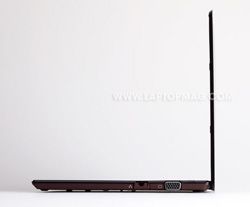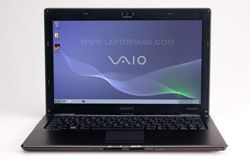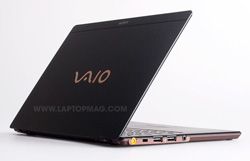Laptop Mag Verdict
The thinnest, lightest, and most expensive netbook also lasts nearly 10 hours on a charge.
Pros
- +
Very light and thin
- +
Excellent endurance
- +
Integrated 3G wireless and GPS
- +
Bright display with good viewing angles
Cons
- -
Expensive
- -
Cramped keyboard and touchpad
- -
Extended battery requires screws
- -
Quiet speakers
Why you can trust Laptop Mag
It's the ultimate status symbol--with a price to match. Once again Sony is shaking up the very clichd netbook category, this time with a design that is not only half as light and half as thin other machines in its class, but also includes a battery that lasts twice as long as many models. Sony didn't stop there, adding integrated 3G and GPS for those mobile tycoons who are able to afford its sticker price ($1,299 to start, $1,499 as configured). Yes, this ultraportable is not for everyone, but for those who want to travel really, really light, the VAIO X (VPCX115KX/B) may be worth the splurge.
Design
Sony touts the VAIO X as the world's lightest notebook, and at 1.4 pounds (with the four-cell battery), it is; even the Viliv S7 Premium, which has a similar processor but a smaller 7.0-inch screen, weighs 1.8 pounds. When you put the extended battery on the VAIO X, the weight--2.2 pounds--is still more than half a pound lighter than most 10-inch netbooks.
Measuring 11.0 x 7.3 x 0.6 inches (without the extended battery), the VAIO X rivals the MacBook Air in terms of thickness; however, its footprint is similar to other netbooks with the same screen size. When the extended battery is attached (by means of two screws that give the underside a quasi-steampunk feel), the back of the system is raised up by about 0.3 inches, and slants towards the user. The battery also doesn't lie flush with the underside of the system; it's designed with gaps in it to aid in the cooling of the netbook.
So how was Sony able to achieve such a thin and light netbook? The VAIO X's chassis is made of a magnesium alloy, and the lid is built from carbon fiber. This material allows the screen to flex, which can be a bit unnerving, but Sony said that it's designed to bend somewhat. Also, by using an Intel Atom Z-series processor, which uses less power (and creates less heat) than the N-series Atom chips in most netbooks, the company was able to make the netbook incredibly slim without requiring a fan.
The lid of our review unit was matte black, as was the inside, with a bronze underside that felt slightly rough to the touch. Sony also offers the netbook with a Champagne Gold lid, but only for the model with a 128GB SSD (more on that later).
Keyboard and Touchpad
Like other Sony notebooks, the keyboard on the VAIO X is island-style, but at 88 percent of full size, it's a bit smaller than most netbooks with 10- to 12-inch screens. Measuring 9.5 x 3.5 inches, the keyboard is about half an inch smaller in both directions than the Toshiba mini NB205, even though the VAIO X has a larger keyboard deck. This is because there's about half an inch of space on either side of the keyboard.
With the exception of an undersized right Shift key, the keys were decently spaced and sized, but overall, it felt slightly cramped. Also, as a result of the netbook's thinness, there's less travel to the keys than on other systems, so we ended up hitting them harder than we're accustomed to.
The VAIO X's touchpad was a decently sized 2.1 x 1.6 inches, and offered little friction. However, like the keyboard, it could have been a smidgen larger, especially considering it's capable of recognizing multitouch gestures, such as pinch and zoom. Two mouse buttons below are also small but responsive.
Display and Audio

Click to enlargeAs befitting a netbook that costs $1,500, the VAIO X's 11.1-inch screen has a higher-than-usual resolution of 1366 x 768; we've only seen this standard on the Gigabyte Touchnote T1028X. This is becoming a more common option, however, such as on theHP Mini 110. While this resolution tends to make icons too small on 10-inch netbooks, we didn't mind it as much on an 11-inch screen.
When watching content streamed over the Web or played off the VAIO X's hard drive, we were impressed with the crispness and wide viewing angles of the display; we could turn it nearly 90 degrees to either side without seeing image reversal or egregious reflections.
Being as thin as it is, we're not surprised at the lack of audio quality in the VAIO X. Songs were thin and tinny; the bass line in Aerosmith's "Dream On" streamed over Pandora was nonexistent, and the speakers could barely fill a small office with sound.
Ports and Webcam
Despite its small stature, Sony manages to cram in most of the connectivity options seen on almost every other netbook. On the left side of the VAIO X are two USB ports and a headphone jack. On the right is a VGA port and Ethernet. Just underneath the front lip is an SD Card reader and a Sony Memory Stick slot. On a system this expensive, we were surprised at the omission of an HDMI port, although since this netbook isn't designed to output HD content, it's not a huge loss.
While not overly detailed, video from the VAIO X's VGA webcam was well balanced, and showed accurate skin tones in a call over Skype.
Performance

Click to enlargeWhile the majority of netbooks feature an N-series Intel Atom processor, the VAIO X is equipped with a 2.0-GHz Intel Atom Z550 CPU, which is paired with 2GB of RAM and a 128GB SSD. While we couldn't get PCMark Vantage to run, the VAIO X notched a Geekbench score of 963, which is the highest we've seen for a netbook, about 140 points above the netbook category average, and about 40 points higher than the Toshiba mini NB205-N210. During everyday tasks, such as writing this review in Microsoft Word and browsing the Web, the netbook performed well, but when watching an episode of The Simpsons at full screen on Hulu, video was slightly choppy.
The netbook's 128GB Samsung SSD booted to Windows 7 Home Premium in 50 seconds (while the average is 55 seconds), and was able to copy a 4.97GB folder of mixed media files at a rate of 27.2 MBps--close to twice the netbook average of 15.2 MBps. When converting a 114MB MPEG-4 to AVI using HandBrake, the VAIO X took 26 minutes and 45 seconds; that's just under 3 minutes faster than the netbook average, but the average ultraportable laptop takes 14:06. The $599 Acer Aspire Timeline 1810T, for example, took 11:24.
Graphics and HD Video Performance
Being a netbook (and not an Ion-powered one at that), the VAIO X doesn't perform graphically demanding chores all that well. Its 3DMark03 score of 364 was nearly 290 points shy of the category average (3DMark06 would not run on the system). Still, a 720p MPEG-4 movie trailer (Cloudy with a Chance of Meatballs) played smoothly at full screen, even when output via VGA to a 32-inch Samsung HDTV (of course, the max output resolution was only 1366 x 768).
While taking the sightseeing tour in Google Earth, we were only able to average 5 frames per second with the app at full screen, and 3D buildings, such as those seen at Googleplex, took nearly half a minute to load. By comparison, the HP Mini 311, which has a discrete Nvidia Ion LE graphics chip, averaged 24 fps on the same test.
Wireless
At 15 feet from our wireless access point, the VAIO X's 802.11b/g/n Wi-Fi card notched a strong throughput of 21.3 Mbps, which is above the average of 19.7 Mbps. At 50 feet, the system fell back to a more mundane 14.6 Mbps, which is just about 2.0 Mbps slower than the category average.
The VAIO X is also equipped with both Verizon Wireless 3G broadband and GPS connectivity. We will update this review once those features have been activated.
Heat
Since it's so thin, one of the main issues with the VAIO X is heat dissipation. During the middle of our transcoding test, the temperature between the G and H keys got as high as 95 degrees Fahrenheit; by aiming our laser thermometer at the space between the extended battery and the bottom of the chassis, we measured a temperature of 105 degrees. The good news is that the VAIO X itself won't touch your lap when you have the external battery attached; that was cool to the touch. However, if you're using only the 4-cell battery, you'll definitely feel the heat. In fact, a sticker on the bottom of the Vaio X warns users that "Operating this computer in contact with your skin for a prolonged period could result in injury."
Battery Life
Aside from its svelte dimensions, one of the other defining features of the VAIO X is its endurance. Sony claims that, with the extended battery, the netbook can get up to 14 hours of runtime (with its standard battery, Sony says to expect just 3 hours). In our LAPTOP Battery Test, the extended battery saw 9 hours and 49 minutes over Wi-Fi (and with GPS and 3G turned off). That blows past the netbook average of 6:10 (for six-cell batteries), and just beats out the runtime of the Toshiba mini NB205-N210 (9:41).
We will update this review with our 3G results, as well as the endurance with the four-cell battery.

Click to enlarge
Configurations
Aside from the black model we received, Sony also offers the same configuration in Champagne Gold; a less expensive model ($1,299) has a smaller 64GB SSD, but only comes in black. Fortunately, both versions come with both the standard and extended batteries.
Software and Support
In addition to Microsoft Windows 7 Home Premium, the VAIO X comes preloaded with a 30-day trial of Norton Internet Security 2009, Microsoft Works, a 90-day trial of AOL, the full version of Microsoft Streets and Trips, and a 60-day trial of Microsoft Office Home and Student 2007; this last one is peculiar, since we don't envision many students buying this netbook.
Sony backs the VAIO X with a one-year limited warranty and 24/7 toll-free telephone assistance. To see how Sony fared on our annual Tech Support Showdown, click here.
Verdict

Click to enlargeSony's VAIO X is so light and stylish, this product is practically in a class by itself. For $1,499, you're getting a system that not only lasts longer than all other netbooks, but it sets a new standard for portability. Additionally, the built-in 3G and GPS ensures that users will be connected wherever they go. However, for an 11-inch system, we were disappointed in this machine's small keyboard and touchpad. If you have the cash, the VAIO X's industrial design will definitely turn heads, but you'll sacrifice ergonomic comfort.
Sony VAIO X Specs
| Bluetooth | Bluetooth 2.1 EDR |
| Brand | Sony |
| CPU | 2.0-GHz Intel Atom Z550 |
| Card Slots | Memory Stick Duo, SD memory reader |
| Company Website | http://www.sonystyle.com |
| Display Size | 11.1 |
| Graphics Card | Intel GMA 500 |
| Hard Drive Size | 128GB |
| Hard Drive Type | SSD Drive |
| Mobile Broadband | Verizon EV-DO Rev A |
| Native Resolution | 1366x768 |
| Operating System | MS Windows 7 Home Premium (32-bit) |
| Ports (excluding USB) | Microphone, Headphone, Ethernet, VGA |
| RAM | 2GB |
| RAM Upgradable to | 2GB |
| Size | 11.0 x 7.3 x 0.6 inches |
| USB Ports | 2 |
| Video Memory | 762MB |
| Warranty/Support | One-year limited/24/7 toll-free phone |
| Weight | 2.2 pounds (with extended battery) |
| Wi-Fi | 802.11b/g/n |
